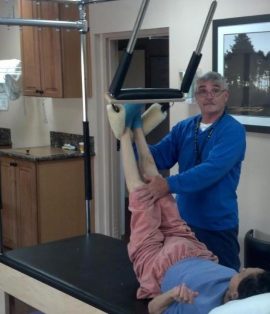 In the past year, Vista Knoll Rehabilitation has expanded its knowledge base by hiring a Physical Therapy Assistant, Michael McFadden, MS, PTA, Certified Polestar Rehabilitation Practitioner, Gold Certified PMA-CPT. Michael is an expert in Pilates, bringing a breath of life and new ideas to promote the success of our patients. Our goal is to position Vista Knoll Rehab as the future of skilled nursing and rehabilitation settings for physical and occupational therapy by providing a diverse treatment approach directed toward each individual patient. Treatment incorporating Pilates principles and providing an environment conducive to helping patients to return to their prior level of function is essential for today’s progressive and successful therapeutic model. At Vista Knoll Specialized Care facility in Vista, CA, the therapy team took a chance in the department and soon saw the results of a progressive, intuitive rehab approach in Pilates that brought its residents a unique approach to recovery.
In the past year, Vista Knoll Rehabilitation has expanded its knowledge base by hiring a Physical Therapy Assistant, Michael McFadden, MS, PTA, Certified Polestar Rehabilitation Practitioner, Gold Certified PMA-CPT. Michael is an expert in Pilates, bringing a breath of life and new ideas to promote the success of our patients. Our goal is to position Vista Knoll Rehab as the future of skilled nursing and rehabilitation settings for physical and occupational therapy by providing a diverse treatment approach directed toward each individual patient. Treatment incorporating Pilates principles and providing an environment conducive to helping patients to return to their prior level of function is essential for today’s progressive and successful therapeutic model. At Vista Knoll Specialized Care facility in Vista, CA, the therapy team took a chance in the department and soon saw the results of a progressive, intuitive rehab approach in Pilates that brought its residents a unique approach to recovery.
The Vista Knoll patients and residents have benefitted from utilizing the Pilates principles and equipment that facilitates treatment goals of improving functional mobility, progressing independence and an integration of core principles for centering, alignment, posture, control, concentration, balance and breath. These pathways provide a power of healing that is optimal and often beyond expectations. Staff, visitors and residents are often impressed and surprised with this “new” clinical model. Because of the many diverse diagnoses at Vista Knoll including orthopedic, cardiac, diabetic, amputee, CVA, pulmonary and cognitive deficits, the Pilates approach offers the flexibility and creativity needed for patients’ progress.
Michael feels Pilates and its apparatus have been overlooked in skilled nursing settings but hopefully soon will be the standard for clinicians who can seek professional coursework and adapt their ideas and methods for the betterment of patient care. Mobility, restoring range of motion, movement patterns and core integration with attainable results in a timely and cost-effective period are essential in the rehab world today. As a result of using the Pilates equipment, which is mostly spring-assisted, patients are able to pattern hundreds of repetitions to re-educate pathways and motor control in all planes and assist levels. This movement awareness and availability has functional carryover for therapeutic goals and discharge with a home program for all levels and family participation.
In our rehabilitation setting, including physical and occupational therapy, we have introduced wall springs and the trapeze table, affording staff multiple stations for treatments. Our high-risk population benefits from strength and balance options in which we utilize creative means to engage participation and safety awareness. Daily treatment includes the methods from both disciplines, which also provides for strong team-building and carryover of ideas. Sit to stand from the wheelchair at one end of the trapeze table with bilateral poles, push-thru bar on the other end in standing or sitting position, and supine leg series on the table all can be performed simultaneously, which is also helpful in small treatment areas.
Here at Vista Knoll, the benefits of our Pilates environment has been evident and has given our residents and returning outpatients the quality-of-life outcomes we strive for as clinicians.
by Kirsten Chesney, DOR, Vista Knoll Specialized Rehab Care, Vista, CA
